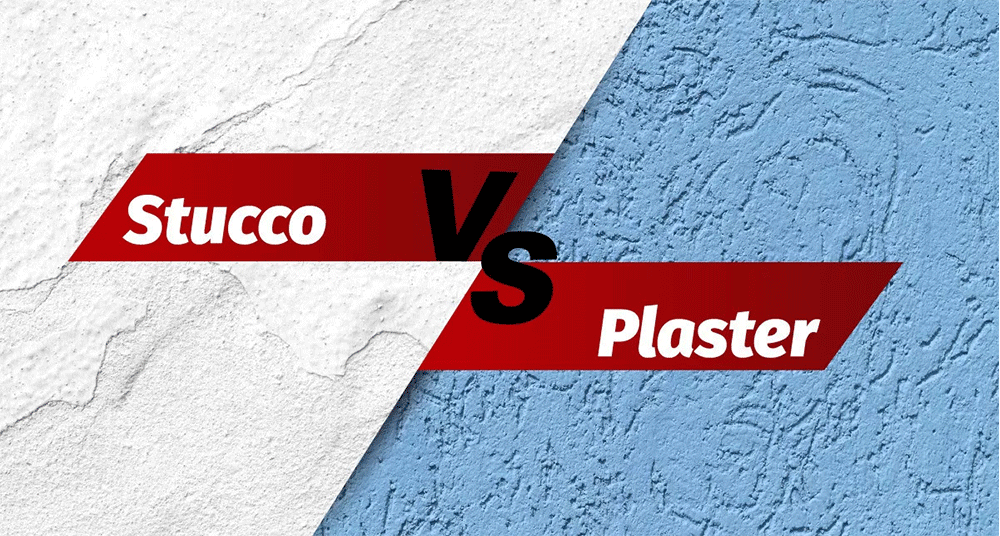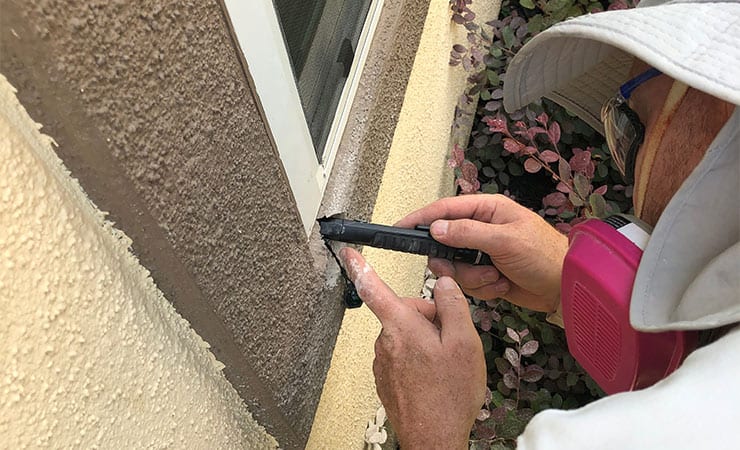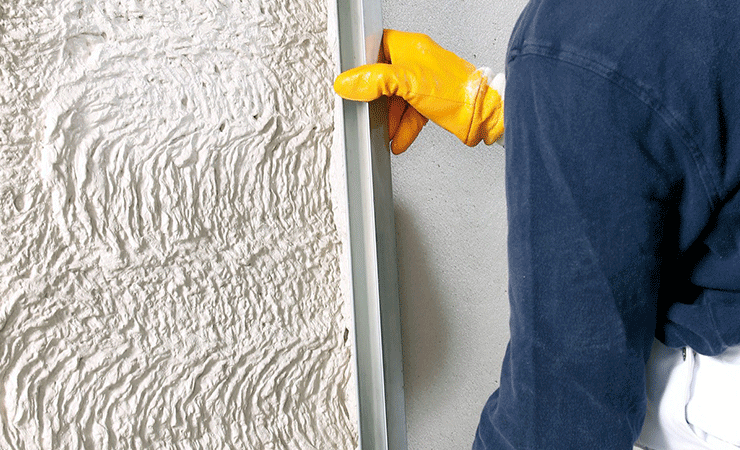Stucco vs. Plaster
Stucco
Stucco is a construction material made of aggregates, a binder, and water. It is applied wet and hardens to a very dense solid. And is used as decorative coating for walls and ceilings, exterior walls, and as sculptural and artistic material in architecture. Stucco can be applied on construction materials. Such as metal, expanded metal lath, concrete, cinder block, or clay brick and adobe for decorative and structural purposes. As a building material, this is a durable, attractive, and weather-resistant wall covering. Stucco is typically applied in one or two thin layers directly over a solid masonry, brick, or stone surface. And the finish coat usually contains an integral color and is typically textured for appearance.

Stucco is a cement-type mixture made of sand, Portland cement, lime, and water. It is considered a thin “finish coat,” the outermost visible layer, and can be painted. Stucco is applied using one of three methods: one-coat, two-coat, and three-coat. They vary by composition, what surfaces they work best with, and speed of completion. One-coat methods are speedier, while three-coat methods are the gold standard and most durable.
Stucco is an exterior home finishing plaster coat found on homes nationwide, thanks to its durability and versatility. It is one of the most durable exterior materials, with a typical life span of 50-100 years or more. Depending on environmental and climate factors. this material provides an excellent seal against rain and snow because it’s seamless, unlike nearly every other form of siding. Stucco walls require the use of a moisture barrier.
If you have stucco on your home or other structure, it can withstand the elements. Including temperature changes, rainstorms, and even hail storms. However, stucco can crack when exposed to extreme temperatures. And even after a few years of exposure to sunlight, it may show signs of weathering. There are two types of stucco patching compounds: the traditional “mud” and pre-mixed versions.
Gypsum role in stucco
Gypsum plays a vital role in stucco, serving as a primary ingredient in gypsum plaster, a specific type of stucco plaster. Gypsum plaster is a versatile, gypsum-based material suitable for application on various internal surfaces, including bricks, blocks, and concrete. It is composed of gypsum, aggregates, and water. When dry gypsum powder is mixed with water, it hardens to form a smooth, durable surface known as gypsum plaster.
This material offers numerous benefits, including excellent insulation, fire resistance, and impact resistance. It significantly reduces construction time, enhances productivity, and provides high strength and a polished finish after drying. Additionally, gypsum plaster exhibits low thermal conductivity, further contributing to its fire-resistant properties.
Stucco is created through the partial dehydration of gypsum, a naturally occurring mineral. Proper control of the dehydration process is crucial to achieving the desired consistency and strength of the stucco. Gypsum plaster, as a specialized type of stucco plaster, relies on gypsum as its core component, making it an essential material in modern construction.
Plaster
Plaster is a construction material that is commonly used for interior walls and ceilings. Gypsum plays a crucial role in plaster as it is the main component of gypsum plaster. Which is a type of plaster. Gypsum plaster is a white cementing material made by partial or complete dehydration of the mineral gypsum.
When dry gypsum powder is mixed with water, it hardens. And this material can be applied over block, brick, or concrete surfaces to form a smooth surface called gypsum plaster. Gypsum plaster is widely used in interior construction due to its properties. It offers excellent acoustic and thermal properties while giving leveled walls with the best finish. Gypsum plaster provides a smooth interior finish and is an ideal base for good quality paints and wallpaper finishes. It can be applied on both smooth and rough surfaces of the wall.
Gypsum plaster is easy to apply and requires less skilled manpower unlike the traditional cement mortar. Gypsum plaster is non-combustible and contains high content of crystal water. In the event of fire, it acts like a barrier and protects the block work. Plaster can be made from other materials besides gypsum, such as cement and sand. Plaster is typically used for indoor surfaces and can be applied to decorative purposes and molded into different shapes.
Gypsum role in plaster
Gypsum plays a pivotal role in the preparation of plaster and is an indispensable component of gypsum plaster. Similar to stucco, gypsum serves as the primary ingredient in this type of plaster, which is specifically designed to provide durable and aesthetically pleasing finishes to walls and ceilings. Gypsum plaster is a white cementing material that is produced by the partial or complete dehydration of the mineral gypsum. This process transforms gypsum into a fine, powdery substance that reacts with water to form a hard, cohesive material upon setting.
When mixed with water, the dry gypsum powder undergoes a chemical reaction known as hydration, which causes it to solidify and harden. This hardened material can then be applied over a variety of surfaces such as blocks, bricks, or concrete to create a smooth, seamless surface referred to as gypsum plaster. This surface not only enhances the visual appeal of the structure but also provides an even base for further decorative finishes.
Gypsum plaster has become a preferred choice in interior construction due to its remarkable properties and ease of application. One of its key advantages is its ability to offer excellent acoustic and thermal insulation, making it a practical solution for creating comfortable indoor environments. Moreover, gypsum plaster provides a perfectly leveled surface that results in walls and ceilings with a superior finish.
Its smooth texture serves as an ideal base for high-quality paints, wallpapers, or decorative treatments, ensuring a flawless final appearance. Another significant benefit of gypsum plaster is its versatility—it can be applied to both smooth and rough wall surfaces, making it suitable for a wide range of construction projects.
In addition to its aesthetic and functional qualities, gypsum plaster is also valued for its quick-setting nature and reduced drying time compared to traditional cement-based plasters. This characteristic makes it a time-efficient option for construction professionals, enabling faster project completion without compromising on quality.
Difference between stucco and plaster
Stucco and plaster are both construction materials that contain cement and water. But they have some differences in their composition, use cases, and installation processes. Here are some key differences between stucco and plaster.

Stucco
-Uses Portland cement as the main component.
-Has a lime base.
-Rougher in texture than plaster.
-Typically used for outdoor surfaces.
-More durable than plaster.
-Can only be applied outside.
-Requires fiberglass to make it more rigid for certain applications.
Plaster
-Uses gypsum as the main component.
-Softer than stucco due to its gypsum base.
-Smoother in texture than stucco.
-Can be placed in molds for custom designs.
-Can be applied indoors and outdoors, making it more versatile than stucco.
-Vulnerable to water damage and mold.
-Can be more susceptible to blunt force damage due to its softer surface.

In summary, while stucco and plaster may look similar, they have different material compositions, use cases, and installation processes. Stucco is typically used for outdoor surfaces and is more durable. While plaster is used for interior walls and can be placed in molds for custom designs.

